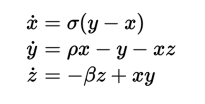E-kitaplarda matematik dizgisi¶
Calibre E-kitap görüntüleyicisi e-kitaplara (EPUB ve HTML dosyaları) gömülü matematiği görüntüleme yeteneğine sahiptir. Matematiği doğrudan TeX veya MathML veya AsciiMath ile dizebilirsiniz. Calibre E-kitap görüntüleyici bunu yapmak için mükemmel MathJax kütüphanesini kullanır. Bu, calibre E-kitap görüntüleyiciyle iyi çalışan, içinde matematik bulunan e-kitaplar oluşturmaya ilişkin kısa bir eğitimdir.
Matematik ifadeleri ile basit bir HTML dosyası¶
Basit bir HTML dosyasının içine satır içi matematik yazabilirsiniz ve calibre E-kitap görüntüleyici bunu düzgün dizilmiş matematik haline getirecektir. Aşağıdaki örnekte matematik için TeX gösterimini kullanıyoruz. Ve işaretlerinin ve küçüktür ve büyüktür işaretlerinin sırasıyla & < ve > olarak yazılması gerektiğine dair küçük bir uyarı ile normal TeX komutlarını kullanabileceğinizi göreceksiniz.
İlk adım calibre’ye bunun matematik içereceğini söylemektir. Bunu, aşağıdaki kod <head>parçasını HTML dosyasının bölümüne ekleyerek yapabilirsiniz:
<script type="text/x-mathjax-config"></script>
İşte bu kadar, artık bir .tex dosyasına yazdığınız gibi matematiksel ifadeleri yazabilirsiniz. Örneğin Lorenz denklemlerini böyle yazabilirsiniz:
<h2>The Lorenz Equations</h2>
<p>
\begin{align}
\dot{x} & = \sigma(y-x) \\
\dot{y} & = \rho x - y - xz \\
\dot{z} & = -\beta z + xy
\end{align}
</p>
Bu parça calibre E-kitap görüntüleyicide aşağıdaki ekran görüntüsüne benziyor.

Lorentz Denklemleri¶
Daha fazla denklem ve satır içi matematik içeren eksiksiz HTML dosyası aşağıda yeniden üretilmiştir. Başkalarına kolayca dağıtabileceğiniz bir e-kitap elde etmek için bu HTML dosyasını calibre’de EPUB’a dönüştürebilirsiniz.
Oluşturulmuş EPUB dosyası: mathjax.epub.
<!DOCTYPE html>
<html>
<!-- Copyright (c) 2012 Design Science, Inc. -->
<head>
<title>Math Test Page</title>
<meta http-equiv="content-type" content="text/html; charset=UTF-8" />
<!-- This script tag is needed to make calibre's ebook-viewer recpgnize that this file needs math typesetting -->
<script type="text/x-mathjax-config">
// This line adds numbers to all equations automatically, unless explicitly suppressed.
MathJax.tex = {tags: 'all'};
</script>
<style>
h1 {text-align:center}
h2 {
font-weight: bold;
background-color: #DDDDDD;
padding: .2em .5em;
margin-top: 1.5em;
border-top: 3px solid #666666;
border-bottom: 2px solid #999999;
}
</style>
</head>
<body>
<h1>Sample Equations</h1>
<h2>The Lorenz Equations</h2>
<p>
\begin{align}
\dot{x} & = \sigma(y-x) \label{lorenz}\\
\dot{y} & = \rho x - y - xz \\
\dot{z} & = -\beta z + xy
\end{align}
</p>
<h2>The Cauchy-Schwarz Inequality</h2>
<p>\[
\left( \sum_{k=1}^n a_k b_k \right)^{\!\!2} \leq
\left( \sum_{k=1}^n a_k^2 \right) \left( \sum_{k=1}^n b_k^2 \right)
\]</p>
<h2>A Cross Product Formula</h2>
<p>\[
\mathbf{V}_1 \times \mathbf{V}_2 =
\begin{vmatrix}
\mathbf{i} & \mathbf{j} & \mathbf{k} \\
\frac{\partial X}{\partial u} & \frac{\partial Y}{\partial u} & 0 \\
\frac{\partial X}{\partial v} & \frac{\partial Y}{\partial v} & 0 \\
\end{vmatrix}
\]</p>
<h2>The probability of getting \(k\) heads when flipping \(n\) coins is:</h2>
<p>\[P(E) = {n \choose k} p^k (1-p)^{ n-k} \]</p>
<h2>An Identity of Ramanujan</h2>
<p>\[
\frac{1}{(\sqrt{\phi \sqrt{5}}-\phi) e^{\frac25 \pi}} =
1+\frac{e^{-2\pi}} {1+\frac{e^{-4\pi}} {1+\frac{e^{-6\pi}}
{1+\frac{e^{-8\pi}} {1+\ldots} } } }
\]</p>
<h2>A Rogers-Ramanujan Identity</h2>
<p>\[
1 + \frac{q^2}{(1-q)}+\frac{q^6}{(1-q)(1-q^2)}+\cdots =
\prod_{j=0}^{\infty}\frac{1}{(1-q^{5j+2})(1-q^{5j+3})},
\quad\quad \text{for $|q|<1$}.
\]</p>
<h2>Maxwell's Equations</h2>
<p>
\begin{align}
\nabla \times \vec{\mathbf{B}} -\, \frac1c\, \frac{\partial\vec{\mathbf{E}}}{\partial t} & = \frac{4\pi}{c}\vec{\mathbf{j}} \\
\nabla \cdot \vec{\mathbf{E}} & = 4 \pi \rho \\
\nabla \times \vec{\mathbf{E}}\, +\, \frac1c\, \frac{\partial\vec{\mathbf{B}}}{\partial t} & = \vec{\mathbf{0}} \\
\nabla \cdot \vec{\mathbf{B}} & = 0
\end{align}
</p>
<h2>Inline Mathematics</h2>
<p>While display equations look good for a page of samples, the
ability to mix math and text in a paragraph is also important. This
expression \(\sqrt{3x-1}+(1+x)^2\) is an example of an inline equation. As
you see, equations can be used this way as well, without unduly
disturbing the spacing between lines.</p>
<h2>References to equations</h2>
<p>Here is a reference to the Lorenz Equations (\ref{lorenz}). Clicking on the equation number will take you back to the equation.</p>
</body>
</html>
Not
The calibre E-book viewer supports MathML as well as TeX, but you must
include the <script type="text/x-mathjax-config"></script> line in
your HTML file otherwise the MathML will not render.
Daha fazla bilgi¶
Calibre E-kitap görüntüleyici matematiği işlemek için MathJax kütüphanesini kullandığından, e-kitaplarda matematik hakkında daha fazla bilgi edinmek ve yardım almak için en iyi yer MathJax web sitesi’dur.
